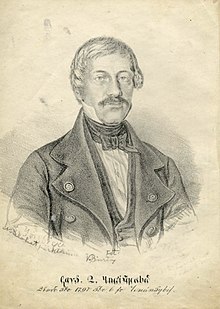Naum Veqilharxhi
Naum Veqilharxhi (born December 6, 1797 in Bredh near Vithkuq, Korça district , † 1846 in Istanbul ) was an Albanian lawyer, scholar and political activist. He is considered to be the first representative of the Albanian national movement Rilindja because in his writings he denounced the foreign rule by the Ottoman Empire and called for the ideas of an Albanian national awakening to be disseminated by means of a modern written language of their own.
Life
Naum Veqilharxhi was born as Naum Panajot Haxhi Llazar Bredhi in 1797 in the south-eastern Banan village of Bredh near Vithkuq in the Korça region. Veqilharxhi completed his studies in Romania , where he emigrated in 1819 after the destruction of his home village Vithkuq. In 1821 he took part in an uprising against the Ottoman Empire (so-called Wallachian uprising ). He later worked as a lawyer in Brăila , where he probably lived until the end of his life. Veqilharxhi was poisoned - probably by Orthodox Greeks - in Istanbul in 1846 .
Political activity
Veqilharxhi did pioneering work in developing awareness of a modern Albanian written language. He was considered a role model for many intellectuals and politicians with nationalist ideas .
"Kultura mund të fitohet vetëm në gjuhën amtare."
"The culture can only be acquired in the mother tongue."
In 1836 Veqilharxhi issued a circular addressed to all wealthy Orthodox Albanians . This circular laments the cultural backwardness of the Albanian people, the cause of which is supposed to be the Turkish rule. To overcome these conditions, he called for the creation of a modern Albanian written language and the dissemination of cultural written material in Albanian . Another political writing by Veqilharxhi was an open letter to his nephew, who was studying in Vienna , in 1846.
Veqilharxhi had already been working on an alphabet since 1824 or 1825, which he published in 1844 in an eight-page booklet entitled Evëtori Shqip Fort i Shkurtër (Albanian alphabet short and memorable) . The second edition in 1845 had 48 pages and was published under the title Faré i ri abétor shqip per djélm nismetore (Brand new textbook for learning the Albanian script) .
The Vithkuq alphabet
Naum Veqilharxhi tried to make the alphabet he developed as religiously and politically neutral as possible by designing the individual letters separately from their counterparts in Arabic , Latin or Greek script. It was able to reproduce the individual sounds of the Albanian language almost perfectly; Only the rendering of the digraphs “gj”, “rr”, “xh” and “zh” was insufficient.
Today the alphabet is often referred to as the Vithkuq alphabet . As early as 1854, the albanologist Johann Georg von Hahn mentioned the alphabet by Naum Veqilharxhi in his book Albanesische Studien as a script by Büthakukje . Carl Faulmann provided an exact representation in Das Buch der Schrift in 1880 as Büthakukye's script .
Fonts
- Circular letter to all wealthy Orthodox Albanians . (1836)
- Evëtori Shqip Fort i Shkurtër. (1844)
- Faré i ri abétor shqip per djélm nismetore. (1845)
- Open letter to his nephew in Vienna (1846)
literature
- Robert Elsie: Historical Dictionary of Albania. Second edition. Toronto and Plymouth 2010: Scarecrow Press. ISBN 978-0-8108-6188-6 .
- Carl Faulmann: The Book of Scripture. Contains the characters and alphabets of all times and of all the peoples of the world. Publishing house of the Imperial and Royal State Printing House. Vienna 1878, 2nd verm. And verb. Edition 1880. Digitized
- Johann Georg von Hahn: Albanian studies. 1854. Digitized
- Miranda Vickers: Shqiptarët . Një histori modern. Bota Shqiptare, 2008, ISBN 978-99956-11-68-2 , 1.5 Shfaqja e lëvizjes kulturore shqiptare , p. 51–52 (English: The Albanians - A Modern History . Translated by Xhevdet Shehu).
Footnotes
- ^ A b Robert Elsie : Historical Dictionary of Albania . In: European Historical Dictionaries . No. 42 . Scarecrow Press, Lanham 2004, ISBN 0-8108-4872-4 , pp. 469 f .
- ^ JG von Hahn: Albanesische Studien. 1854. pp. 292f.
- ↑ C. Faulmann: The book of writing. Contains the characters and alphabets of all times and of all the peoples of the world. Publishing house of the Imperial and Royal State Printing House. Vienna 1878, 2nd verm. And verb. Ed. 1880, p. 182.
| personal data | |
|---|---|
| SURNAME | Veqilharxhi, Naum |
| ALTERNATIVE NAMES | Naum Panajot Haxhi Llazar Bredhi |
| BRIEF DESCRIPTION | Albanian educator |
| DATE OF BIRTH | December 6, 1797 |
| PLACE OF BIRTH | Bredh at Korça |
| DATE OF DEATH | 1846 |
| Place of death | Istanbul |

